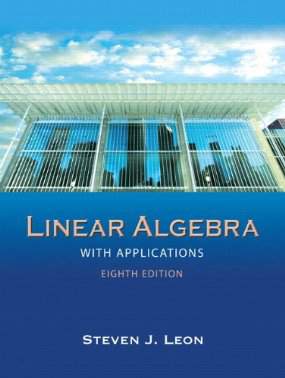Connecting...

This is a quick preview of the lesson. For full access, please Log In or Sign up.
For more information, please see full course syllabus of Linear Algebra
For more information, please see full course syllabus of Linear Algebra
Linear Algebra Dot Product & Matrix Multiplication
Lecture Description
Previously we discussed what matrices are and what some operations are that you can do with them. Now we’ll discuss two more operations called the dot product and matrix multiplication. If you’ve taken a physics course, you’ve definitely been introduced to a vector, and perhaps even the dot product of vectors. A matrix dot product is similar to a vector dot product, and a way to keep a clear head about this is to think of a matrix as rows of vectors. The other operation discussed is one that can often be confused with other operations; be sure you fully understand the process of matrix multiplication before moving on.
Bookmark & Share
Embed
Share this knowledge with your friends!
Copy & Paste this embed code into your website’s HTML
Please ensure that your website editor is in text mode when you paste the code.(In Wordpress, the mode button is on the top right corner.)
×
- - Allow users to view the embedded video in full-size.
Next Lecture
Previous Lecture










































 Answer Engine
Answer Engine




1 answer
Sun Dec 30, 2018 7:29 AM
Post by Erico Lendzian on December 27, 2018
There's an error at 10:58, when doing the first example of matrix multiplication, Prof. Hovasapian says "...the number of columns of the first one is equal to the number of columns of the second one"
1 answer
Mon Feb 8, 2016 2:16 AM
Post by Mind Trap on February 4, 2016
Hello Professor!
although i think i understand the idea behind them for reassurance could you please address the difference between a vector, a matrix and an array?
3 answers
Sun Sep 9, 2012 8:29 AM
Post by Tomer Eiges on September 8, 2012
When you explained the definition of a dot product you used the standard form of the vector instead of just the magnitude... in other words you said that a vector can be equal to a scalar
1 answer
Last reply by: Josh Winfield
Mon Jan 27, 2014 10:27 PM
Post by Real Schiran on March 1, 2012
Very nice explanation !!!!
1 answer
Sun Jul 15, 2012 9:11 PM
Post by Damion Wright on February 6, 2012
Hi, can I just check something with you? Toward the end you gave an example matrix AB where you worked out the first number of the second row to be 8, I keep getting 10. Am I making a mistake over and over again? I am incredibly new to mathematics so take all of my own findings with a mountain of salt :P P.s. example was at about 37:05. Thanks in advance!